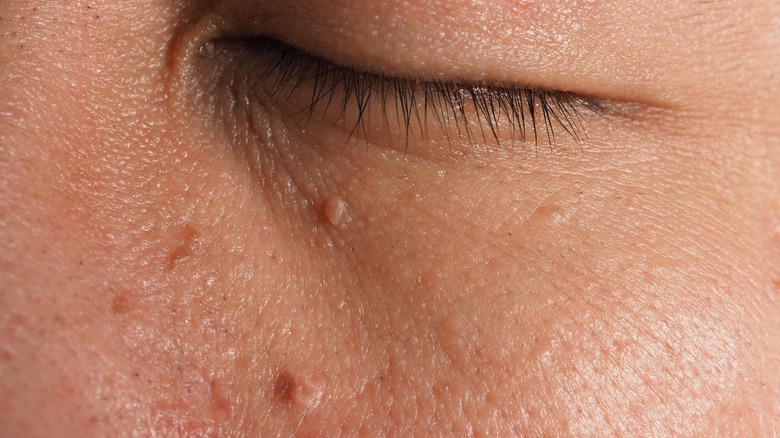Here's Why Skin Tags Are Common When Pregnant
The Cleveland Clinic describes skin tags as small, raised growths that can present in various places on the body. They are typically harmless and can often be compared to dark moles in their appearance. While most won't grow larger than a few millimeters, some can reach lengths of a few centimeters.
Skin tags grow most frequently in places where the skin experiences friction with itself, such as in armpits and in the groin or on the inner thighs (per Cleveland Clinic). This movement causes the skin to produce extra cells that extend out.
If you have skin tags, you may not need to rush to a doctor for treatment. There are ways you can treat them at home, points out Healthline. Simple home remedies include tea tree oil, banana peels, and apple cider vinegar, all of which will encourage the skin tag to fall off. There are also over-the-counter remedies you can buy at your local pharmacy that typically use extremely cold temperatures to destroy the tissue of the skin tag. However, it's important not to try and cut skin tags yourself, which can lead to bleeding and infection.
While the main risk factor for developing skin tags is simply aging, there are other conditions that can increase the likelihood that you'll notice them on your skin, including obesity, skin diseases, a family history, and pregnancy (via Cleveland Clinic). In fact, there are specific reasons why skin tags are more likely to develop during pregnancy. Here's what we know.
Hormones play a big role in the development of skin tags during pregnancy
If you're pregnant, you may notice a sudden emergence of skin tags. However, there is no need to worry as this is perfectly normal. In fact, a 2007 study found that 12% of pregnant women experienced them.
The NHS pointed out that skin tags often occur during pregnancy due to fluctuating hormones. This was explored in a 2010 study published in the Indian Journal of Dermatology that found a link between increased estrogen levels and the growth of skin tags. Estrogen is yet another important hormone for the development of the fetus and levels rise throughout the course of the pregnancy, as per Healthline. This could also explain why skin tags start to become more common after the second trimester (via Healthline).
Since skin tags can pop up as the result of friction, the weight gain that naturally accompanies pregnancy can lead to their development as well, explains Mom Junction. The specific locations in which you're likely to see them emerge varies from person to person, although they tend to be in areas where the skin folds onto itself. Think beneath the breasts and along the vagina. That being said, you may be pleased to learn that oftentimes, skin tags will disappear on their own after pregnancy.


